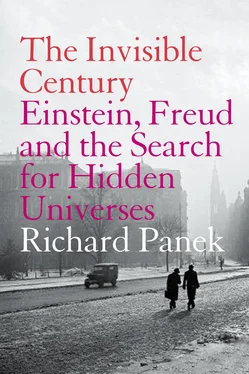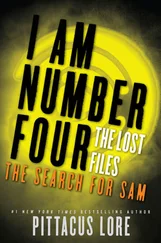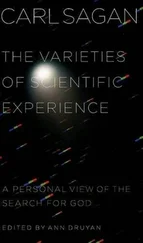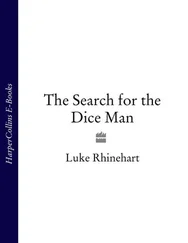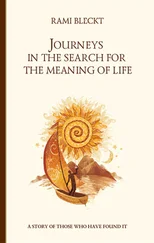EINSTEIN, FREUD
AND
THE SEARCH FOR
HIDDEN UNIVERSES

DEDICATION Dedication Epigraph Prologue I. MIND OVER MATTER One: More Things in Heaven Two: More Things on Earth Three: Going to Extremes II. MATTER OVER MIND Four: A Leap of Faith Five: The Descent of a Man III. THE TREMBLING OF THE DEWDROP Six: A Discourse Concerning Two New Sciences Notes Bibliography Index Acknowledgments About the Author Other Book by Copyright About the Publisher
Once again, for Meg Wolitzer, with love
Epigraph Epigraph Prologue I. MIND OVER MATTER One: More Things in Heaven Two: More Things on Earth Three: Going to Extremes II. MATTER OVER MIND Four: A Leap of Faith Five: The Descent of a Man III. THE TREMBLING OF THE DEWDROP Six: A Discourse Concerning Two New Sciences Notes Bibliography Index Acknowledgments About the Author Other Book by Copyright About the Publisher
Q: “Is the invisible visible?”
A: “Not to the eye.”
—from an 1896 interview with
Wilhelm Conrad Röntgen,
the discoverer of the X-ray
Cover
Title Page THE INVISIBLE CENTURY EINSTEIN, FREUD AND THE SEARCH FOR HIDDEN UNIVERSES
Dedication DEDICATION Dedication Epigraph Prologue I. MIND OVER MATTER One: More Things in Heaven Two: More Things on Earth Three: Going to Extremes II. MATTER OVER MIND Four: A Leap of Faith Five: The Descent of a Man III. THE TREMBLING OF THE DEWDROP Six: A Discourse Concerning Two New Sciences Notes Bibliography Index Acknowledgments About the Author Other Book by Copyright About the Publisher Once again, for Meg Wolitzer, with love
Epigraph Epigraph Epigraph Prologue I. MIND OVER MATTER One: More Things in Heaven Two: More Things on Earth Three: Going to Extremes II. MATTER OVER MIND Four: A Leap of Faith Five: The Descent of a Man III. THE TREMBLING OF THE DEWDROP Six: A Discourse Concerning Two New Sciences Notes Bibliography Index Acknowledgments About the Author Other Book by Copyright About the Publisher Q: “Is the invisible visible?” A: “Not to the eye.” —from an 1896 interview with Wilhelm Conrad Röntgen, the discoverer of the X-ray
Prologue
I. MIND OVER MATTER
One: More Things in Heaven
Two: More Things on Earth
Three: Going to Extremes
II. MATTER OVER MIND
Four: A Leap of Faith
Five: The Descent of a Man
III. THE TREMBLING OF THE DEWDROP
Six: A Discourse Concerning Two New Sciences
Notes
Bibliography
Index
Acknowledgments
About the Author
Other Book by
Copyright
About the Publisher
They met only once. During the New Year’s holiday season of 1927, Albert Einstein called on Sigmund Freud, who was staying at the home of one of his sons in Berlin. Einstein, at forty-seven, was the foremost living symbol of the physical sciences, while Freud, at seventy, was his equal in the social sciences, but the evening was hardly a meeting of the minds. When a friend wrote Einstein just a few weeks later suggesting that he allow himself to undergo psychoanalysis, Einstein answered, “I regret that I cannot accede to your request, because I should like very much to remain in the darkness of not having been analyzed.” Or, as Freud wrote to a friend regarding Einstein immediately after their meeting in Berlin, “He understands as much about psychology as I do about physics, so we had a very pleasant talk.”
Freud and Einstein shared a native language, German, but their respective professional vocabularies had long since diverged, to the point that they now seemed virtually irreconcilable. Even so, Freud and Einstein had more in common than they might have imagined. Many years earlier, at the beginning of their respective scientific investigations, they both had reached what would prove to be the same pivotal juncture. Each had been exploring one of the foremost problems in his field. Each had found himself confronting an obstacle that had defeated everyone else exploring the problem. In both their cases, this obstacle was the same: a lack of more evidence. Yet rather than retreat from this absence and look elsewhere or concede defeat and stop looking, Einstein and Freud had kept looking anyway.
Looking, after all, was what scientists did. It was what defined the scientific method. It was what had precipitated the Scientific Revolution, some three centuries earlier. In 1610, Galileo Galilei reported that upon looking through a new instrument into the celestial realm he saw forty stars in the Pleiades cluster where previously everyone else had seen only six, five hundred new stars in the constellation of Orion, “a congeries of innumerable stars” in another stretch of the night sky, and then, around Jupiter, moons. Beginning in 1674, Antonius von Leeuwenhoek reported that upon looking at terrestrial objects through another new instrument he saw “upwards of one million living creatures” in a drop of water, “animals” numbering more than “there were human beings in the united Netherlands” in the white matter on his gums, and then, in the plaque from the mouth of an old man who’d never cleaned his teeth, “an unbelievably great number of living animalcules, a-swimming more nimbly than any I had ever seen up to this time.”
Such discoveries were not without precedent. They came, in fact, at the end of the Age of Discovery. If an explorer of the seas could discover a New World, then why should an explorer of the heavens not discover new worlds? And if those same sea voyages proved that the Earth could house innumerable creatures previously unknown, then why not earth itself or water or flesh?
What was without precedent in the discoveries of Galileo and Leeuwenhoek, however, was the means by which they reached them. Between 1595 and 1609, spectacle makers in the Netherlands had fit combinations of lenses together in two new instruments that performed similar, though distinct, optical tricks. The combination of lenses in one instrument made distant objects appear nearer, the combination in the other made small objects appear larger; and for the first time in history investigators of nature had at their disposal tools that served as an extension of one of the five human senses. As much as the discoveries themselves, what revolutionized science over the course of the seventeenth century was a new means of discovery and what it signified: There is more to the universe than meets the naked eye.
Who knew? After all, these instruments might easily have revealed nothing beyond what we already knew to be there, and what we already knew to be there might easily have been all there was to know. The naked eye alone didn’t have to be inadequate as a means of investigating nature; the invention of these instruments didn’t have to open two new frontiers. But it was; and they did.
For thousands of years, the number of objects in the heavens had been fixed at six thousand or so. Now, there were … more. Since the Creation, or at least since the Flood, the number of kinds of creatures on Earth, however incalculable as a practical matter, had nonetheless been fixed. Now, there were … more. “There are more things in heaven and earth, Horatio, than are dreamt of in your philosophy”: When Shakespeare wrote these words in 1598 or 1599, at the very cusp of the turn of the seventeenth century, he was referring to the understandable assumption among practitioners of what would soon become the old philosophy that much of what was as yet unknown must remain unknown forever, and for the next three hundred years the practitioners of what they themselves came to call the New Philosophy frequently cited it as the last time in history that someone could have written so confidently about civilization’s continuing ignorance of, and estrangement from, the universe.
Читать дальше
